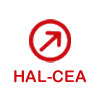Nanopix v1: a compact miniaturized coded aperture gamma imager
Résumé
This article explores the complex challenges associated with detecting and identifying radioactive hotspots in the nuclear industry using gamma cameras. Gamma cameras facilitate the localization of radioactive hotspots by overlaying a visualization of radioactivity onto a visible image. In the nuclear industry, gamma rays are observed in an energy range spanning from 59.5 keV (Am-241) to 1.3 MeV (Co-60).
The motivation for this exploration stems from a specific challenge: characterizing hot-cells inaccessible to human operators. At the ORANO La Hague radioactive waste reprocessing plant, access to these restricted regions is possible through apertures with diameters ranging from 8 to 10 cm. In collaboration, the Nanopix-v1, characterized by its compact form as a coded mask gamma imaging system, with dimensions of 8 × 5.1 × 4.3 cm³ and a mass of 268 g, was developed through the synergistic efforts of CEA List and X-ray Imaging Europe (XIE) in partnership with ORANO.
This article conducts a detailed examination of the laboratory and in situ performance of the Nanopix-v1, carried out within the challenging operational environment of the La Hague radioactive waste reprocessing plant. The focal point of the article is a comprehensive exploration of the technological components supporting the Nanopix-v1, along with an explanation of the coded mask imaging localization methodologies that underpinned the rigorous evaluation process. The performance of the gamma camera is evaluated through a series of carefully conducted trials, aimed at evaluating the angular resolution and minimum measurement time, including laboratory conditions, experimentation within a metrological Cs-137 irradiator, and practical implementation at the ORANO La Hague site.
| Origine | Fichiers produits par l'(les) auteur(s) |
|---|

